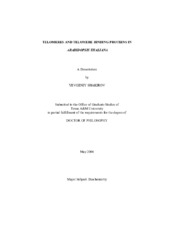| dc.description.abstract | Telomeres are important protein-DNA structures at the ends of linear eukaryotic chromosomes that are necessary to prevent chromosome fusions and exonuclease attack. We found that telomere tracts in Arabidopsis are fairly uniformly distributed throughout a size range of 2-9kb. Unexpectedly, telomeres in WS plants displayed a bimodal size distribution with some individuals exhibiting 4-8 kb telomeres and others 2-5 kb telomeres. We also examined the dynamics of telomere tracts on individual chromosome ends. Following the fate of telomeres in plants through successive generations, we found that the shortest telomeres were typically elongated in the subsequent generation, while the longest telomeres were usually shortened. Thus, telomere length homoeostasis is achieved through intermittent telomerase action on shorter telomeres to attain an optimal size.Single-strand telomere binding proteins were also analyzed. Four major telomere binding protein complexes from cauliflower were identified and their DNA-binding properties characterized. The DNA-binding component of one of the complexes was purified and analyzed by mass-spectrometry. Peptide mass data was used to search for putative protein candidates from the Arabidopsis thaliana database. Additionally, two Arabidopsis genes, AtPot1 and AtPot2, were identified and characterized. The genes encode two single-strand telomeric DNA binding proteins. AtPot1 and AtPot2 proteins can homo- and heterodimerize in vitro. Pot1 protein predominantly localizes to the nucleolus, whereas Pot2 is exclusively nuclear. Plants over-expressing full-length Pot1 and Pot2 proteins had no obvious phenotype, while over-expression of P2DBD and P1∆DBD caused moderate telomere shortening. Plants over-expressing P2DBD had severe morphological and reproductive defects, multiple chromosome abnormalities and aneuploidy. Over-expression of a chimeric protein DBD-P1∆DBD led to rapid telomere shortening, confirming the involvement of Arabidopsis Pot proteins in telomere length maintenance. Intriguingly, telomerase in DBD-P1∆DBD-EYFP plants is inactivated, suggesting that Pot proteins are also involved in regulation of telomerase activity. The analysis of Arabidopsis telomeres and telomere binding proteins will provide additional information towards understanding the role of the telomeric nucleoprotein complex in eukaryotic chromosome biology. | en |


